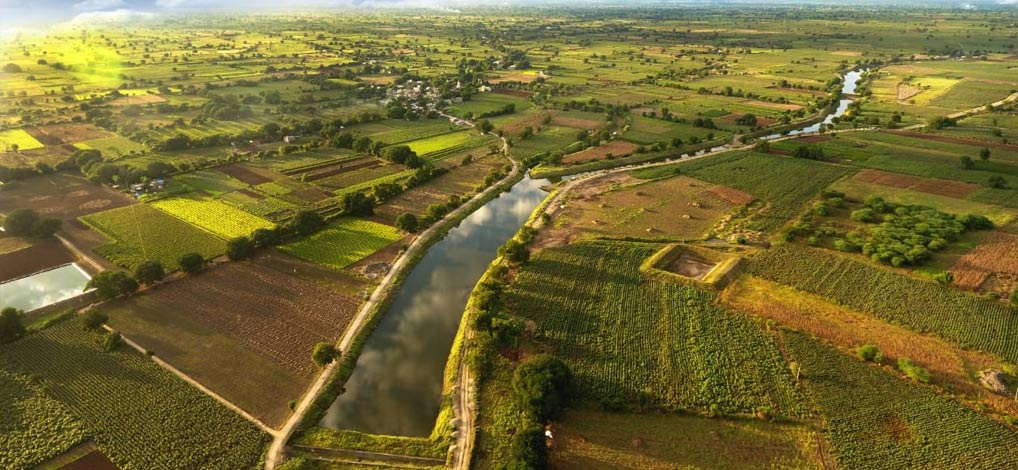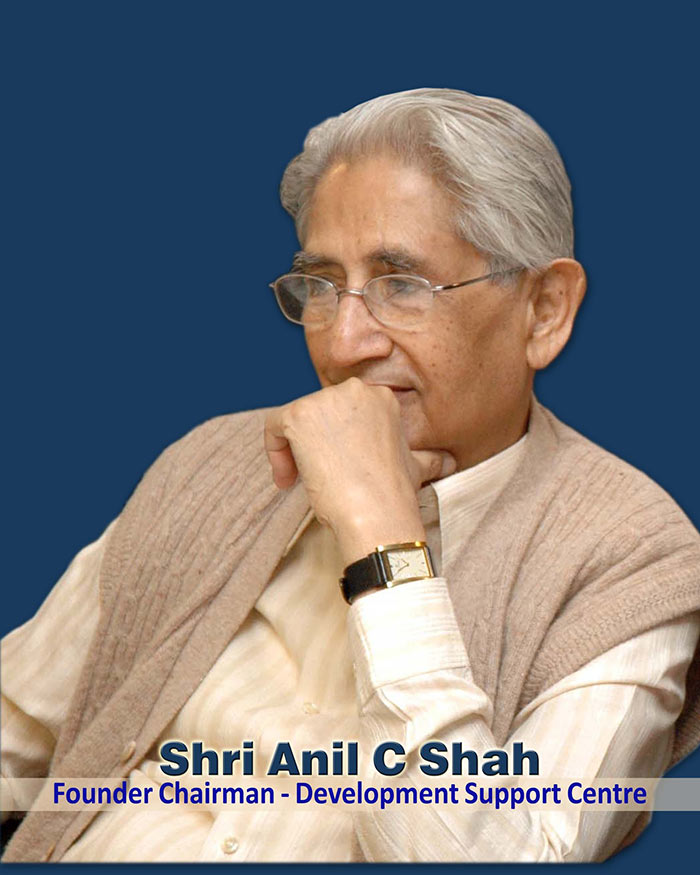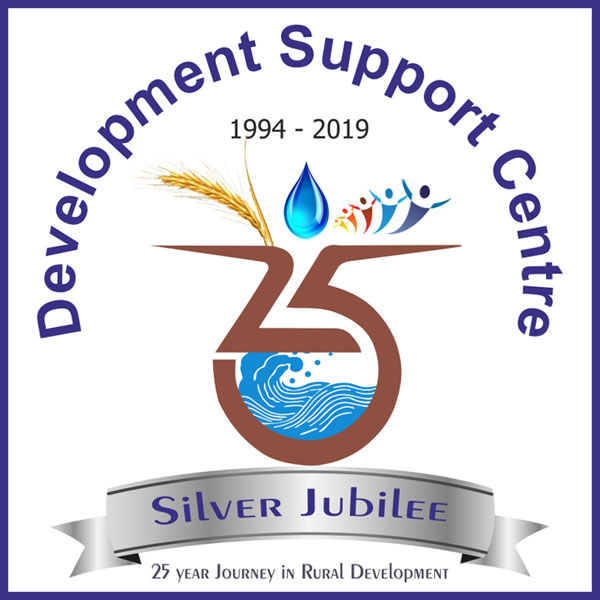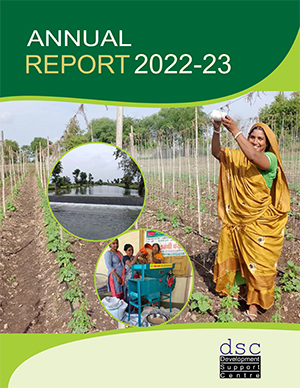- A Study in Self Help Groups, Delna Karanjia, 1999. 33p.
 The study looks into the contributions of Self Help Groups in ensuring equitable distribution of benefits in watershed programme implemented by DSC and achievement of long term goals set by DSC.
The study looks into the contributions of Self Help Groups in ensuring equitable distribution of benefits in watershed programme implemented by DSC and achievement of long term goals set by DSC.
- Application of Remote Sensing and Geographic Information Systems (GIS) in Participatory Natural Resource Management: An Exploratory Study, Asif Pradhan, 2001. 118p.
 An examination of the use of remote sensing technology (RST) in watershed planning by government and non-government organisations, especially the sequencing when the RST is used with the participatory approach.
An examination of the use of remote sensing technology (RST) in watershed planning by government and non-government organisations, especially the sequencing when the RST is used with the participatory approach.
- A Detailed Report on Impact Assessment of Training in Watershed Development Organisation, DSC (Ahmedabad), Smita Nariyal, 2001-02. 106p.
 DSC is one of the institutes recognised by Government of Gujarat for training the watershed functionaries. Therefore it was important for DSC to understand Impact of DSC's training on its participants and the scope for its improvement. The objectives of this study were assessing trainee familiarity with concepts and processes of watershed development programme; investigating the extent to which participants have tried to operationalise approaches/concepts/practices learned during training; determining the extent to which participants disseminated the information/concepts. Ascertain current and future training needs of PIAs in terms of topic and methodology.
DSC is one of the institutes recognised by Government of Gujarat for training the watershed functionaries. Therefore it was important for DSC to understand Impact of DSC's training on its participants and the scope for its improvement. The objectives of this study were assessing trainee familiarity with concepts and processes of watershed development programme; investigating the extent to which participants have tried to operationalise approaches/concepts/practices learned during training; determining the extent to which participants disseminated the information/concepts. Ascertain current and future training needs of PIAs in terms of topic and methodology.
- Lessons from the Field vis-vis MoRD Guidelines in Watershed Development Programmes with Reference to Inclusion of Forestland in the Watershed Development Area, Shailesh Mujumdar, 2002. 128p.
 An enquiry into whether the ridge to valley principle of watershed development which requires treating forestland within the watershed is adhered to by project implementing agencies as prescribed in the guidelines.
An enquiry into whether the ridge to valley principle of watershed development which requires treating forestland within the watershed is adhered to by project implementing agencies as prescribed in the guidelines.
- Impact Assessment of Watershed Programmes Implemented by DSC, Ritesh Kumar Sinha, 2002. 130p.
 Examination of the economic and social impact of watershed development project and people's participation in project related activities in the villages of Dhari taluka, Amreli district.
Examination of the economic and social impact of watershed development project and people's participation in project related activities in the villages of Dhari taluka, Amreli district.
- Comparative Analysis of Panchayati Institutions and Other Agencies as Project Implementation Agencies in Watershed Development, Aman Gupta, 2002. 68p.
 The study is a comparative analysis of the performance of government organisations, non-governmental organisations, and panchayati raj institutions as project implementing agencies of watershed programmes.
The study is a comparative analysis of the performance of government organisations, non-governmental organisations, and panchayati raj institutions as project implementing agencies of watershed programmes.
- Maintenance of Physical Assets: Role of Village Institutions (Part I), Sachin Kumar Badkas, 2003. 57p
 An examination of the initiatives taken by user groups and village institutions to manage the physical assets created under watershed programme. The study was conducted with the following objectives to understand the expected role of PIA / PRI / WA / WC / UG, understanding / awareness of each of these of their role, the actual roles being played by each in the maintenance of assets post project and the consequence of not maintaining the physical assets.
An examination of the initiatives taken by user groups and village institutions to manage the physical assets created under watershed programme. The study was conducted with the following objectives to understand the expected role of PIA / PRI / WA / WC / UG, understanding / awareness of each of these of their role, the actual roles being played by each in the maintenance of assets post project and the consequence of not maintaining the physical assets.
- Cost Benefit Analysis of Watershed Programme, Sachin Kumar, 2003. 89p.
 The pilot study was conducted in Rampur and Hirava villages of Dhari block of Amreli district, Gujarat. The main objectives of the study were to identify and estimate the direct benefits and costs involved in the watershed development program implemented in the study, Also to understand and analyse benefits of watershed development program.
The pilot study was conducted in Rampur and Hirava villages of Dhari block of Amreli district, Gujarat. The main objectives of the study were to identify and estimate the direct benefits and costs involved in the watershed development program implemented in the study, Also to understand and analyse benefits of watershed development program.
- Impact Assessment of Development Support Centre's (DSC) Intervention in Watershed management on Livelihoods of the Rural Communities, Siddhartha Gupta, 2005. 83p.
 Watershed programme aims at improving the livelihoods of the rural communities. This pilot study was conducted in one village of Dhari Taluka of Amreli district, Gujarat where DSC has implemented watershed programme. The objectives of this study were to identify the various stakeholders (only from the village communities), primary and secondary, in the watershed development programme. Identify their existing sources of livelihoods with the respective contributions to their overall household economy. Identify the various institutions affecting their livelihoods and the specific effect of the institutions formed under the watershed development programme, and their inter-relationships.
Watershed programme aims at improving the livelihoods of the rural communities. This pilot study was conducted in one village of Dhari Taluka of Amreli district, Gujarat where DSC has implemented watershed programme. The objectives of this study were to identify the various stakeholders (only from the village communities), primary and secondary, in the watershed development programme. Identify their existing sources of livelihoods with the respective contributions to their overall household economy. Identify the various institutions affecting their livelihoods and the specific effect of the institutions formed under the watershed development programme, and their inter-relationships.
 Publications
Publications
 Research Studies by Students/ Research Papers
Research Studies by Students/ Research Papers  The study looks into the contributions of Self Help Groups in ensuring equitable distribution of benefits in watershed programme implemented by DSC and achievement of long term goals set by DSC.
The study looks into the contributions of Self Help Groups in ensuring equitable distribution of benefits in watershed programme implemented by DSC and achievement of long term goals set by DSC.  An examination of the use of remote sensing technology (RST) in watershed planning by government and non-government organisations, especially the sequencing when the RST is used with the participatory approach.
An examination of the use of remote sensing technology (RST) in watershed planning by government and non-government organisations, especially the sequencing when the RST is used with the participatory approach.  DSC is one of the institutes recognised by Government of Gujarat for training the watershed functionaries. Therefore it was important for DSC to understand Impact of DSC's training on its participants and the scope for its improvement. The objectives of this study were assessing trainee familiarity with concepts and processes of watershed development programme; investigating the extent to which participants have tried to operationalise approaches/concepts/practices learned during training; determining the extent to which participants disseminated the information/concepts. Ascertain current and future training needs of PIAs in terms of topic and methodology.
DSC is one of the institutes recognised by Government of Gujarat for training the watershed functionaries. Therefore it was important for DSC to understand Impact of DSC's training on its participants and the scope for its improvement. The objectives of this study were assessing trainee familiarity with concepts and processes of watershed development programme; investigating the extent to which participants have tried to operationalise approaches/concepts/practices learned during training; determining the extent to which participants disseminated the information/concepts. Ascertain current and future training needs of PIAs in terms of topic and methodology.  An enquiry into whether the ridge to valley principle of watershed development which requires treating forestland within the watershed is adhered to by project implementing agencies as prescribed in the guidelines.
An enquiry into whether the ridge to valley principle of watershed development which requires treating forestland within the watershed is adhered to by project implementing agencies as prescribed in the guidelines.  Examination of the economic and social impact of watershed development project and people's participation in project related activities in the villages of Dhari taluka, Amreli district.
Examination of the economic and social impact of watershed development project and people's participation in project related activities in the villages of Dhari taluka, Amreli district.  The study is a comparative analysis of the performance of government organisations, non-governmental organisations, and panchayati raj institutions as project implementing agencies of watershed programmes.
The study is a comparative analysis of the performance of government organisations, non-governmental organisations, and panchayati raj institutions as project implementing agencies of watershed programmes.  An examination of the initiatives taken by user groups and village institutions to manage the physical assets created under watershed programme. The study was conducted with the following objectives to understand the expected role of PIA / PRI / WA / WC / UG, understanding / awareness of each of these of their role, the actual roles being played by each in the maintenance of assets post project and the consequence of not maintaining the physical assets.
An examination of the initiatives taken by user groups and village institutions to manage the physical assets created under watershed programme. The study was conducted with the following objectives to understand the expected role of PIA / PRI / WA / WC / UG, understanding / awareness of each of these of their role, the actual roles being played by each in the maintenance of assets post project and the consequence of not maintaining the physical assets.  The pilot study was conducted in Rampur and Hirava villages of Dhari block of Amreli district, Gujarat. The main objectives of the study were to identify and estimate the direct benefits and costs involved in the watershed development program implemented in the study, Also to understand and analyse benefits of watershed development program.
The pilot study was conducted in Rampur and Hirava villages of Dhari block of Amreli district, Gujarat. The main objectives of the study were to identify and estimate the direct benefits and costs involved in the watershed development program implemented in the study, Also to understand and analyse benefits of watershed development program.  Watershed programme aims at improving the livelihoods of the rural communities. This pilot study was conducted in one village of Dhari Taluka of Amreli district, Gujarat where DSC has implemented watershed programme. The objectives of this study were to identify the various stakeholders (only from the village communities), primary and secondary, in the watershed development programme. Identify their existing sources of livelihoods with the respective contributions to their overall household economy. Identify the various institutions affecting their livelihoods and the specific effect of the institutions formed under the watershed development programme, and their inter-relationships.
Watershed programme aims at improving the livelihoods of the rural communities. This pilot study was conducted in one village of Dhari Taluka of Amreli district, Gujarat where DSC has implemented watershed programme. The objectives of this study were to identify the various stakeholders (only from the village communities), primary and secondary, in the watershed development programme. Identify their existing sources of livelihoods with the respective contributions to their overall household economy. Identify the various institutions affecting their livelihoods and the specific effect of the institutions formed under the watershed development programme, and their inter-relationships. 













